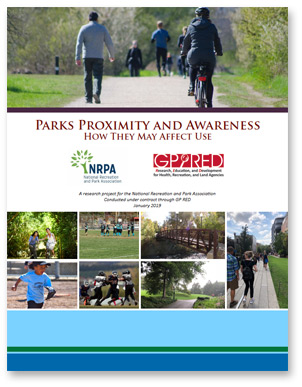Parks Proximity and Awareness
How They May Affect Use
A research project for the National Recreation and
Park Association, conducted under contract through
GP RED, January 2019.
Parks are essential to the physical, social, environmental, and economic health of a community. For about the past 15 years, agencies and researchers have often focused planning efforts on addressing “proximity” to parks as being key to community equity. For example, the National Recreation and Park Association (NRPA), The Trust for Public Land, and the Urban Land Institute have been leading a nationwide movement, the “10-minute walk campaign,” to ensure that there’s a great park within a 10-minute walk of every person, in every neighborhood, in every city across America (https://www.nrpa.org/our-work/partnerships/initiatives/10-minute-walk/).
Historically, level of service (LOS) analysis has looked mostly at availability of the number of components (known as capacity analysis – or X number of amenities per 1,000 population) and the proximity of those components to residents. The academic research is now questioning whether availability and proximity are really the key driving elements for participation and use (Cohen et al. 2017; Layton, 2016). NRPA and GP RED have suggested that the primary aspects of community use (participation) are both: 1) availability of program locations and facilities (proximity of the components of a community system), and also 2) satisfaction with and awareness of those components. In 2018, GP RED was contracted by NRPA to look at exploring, “How the aspects of proximity to and awareness of parks and recreation (P&R) components are perceived, and how may they potentially affect usage of our community P&R systems.” The research explored both objective proximity (actual measured distance from one’s home to a park), perceptions of proximity (how far they think they are from a park), along with awareness of availability (do they know or can they find out where the parks and facilities are).
This report includes a summary of relevant literature, along with aggregated analysis of results from 119 previous random sampling surveys from diverse communities conducted since 2005 during professional P&R planning projects. A case study was included to provide analysis of awareness and proximity issues for two agencies, Cary, North Carolina, and Montgomery County, Maryland, using component-based methods for levels of service analysis, and available marketing documents and input from these agencies. Key elements of awareness, potential strategies (e.g. marketing, social media, signage, and wayfinding), and key management takeaways were examined.
CLICK HERE to read the full report.

